The Supermicro X10SDV-7TP8F is an amazing platform. When I first heard that Intel was moving up the launch date of the 12 core and 16 core Xeon D parts (formerly Broadwell-DE) I was extremely excited about the possibilities. Supermicro sent us a note not long thereafter and asked if we wanted to review an Intel Xeon D-1587 (top end Xeon D 16C/ 32T part) platform with dual SFP+ and an onboard LSI HBA. Unlike the smaller mITX variants (e.g. the Supermicro X10SDV-16C-TLN4F) the motherboard is a larger form factor which provides additional room for many new features. This is the same platform we used in our Intel Xeon D 12 and 16 core launch piece and for the Intel Xeon D-1587 benchmarks piece recently.
Test Configuration
Given the larger footprint of this platform, we needed to use additional components for testing.
- CPU: Intel Xeon D-1587 (embedded)
- Motherboard: Supermicro X10SDV-7TP8F
- Memory: 128GB – 4x Micron 32GB DDR4 ECC RDIMMs
- SSD: 4x Intel DC S3700 400GB, 1x Samsung SM951 512GB, 1x Intel DC P3600 400GB(add-in HHHL card), 1x 64GB Supermicro mSATA boot device,
- HDD: 4x Seagate 1TB 2.5″ Enterprise Capacity V3 7200rpm
- Operating Systems: Ubuntu 14.04.4 LTS, Windows Server 2012 R2, CentOS 7, OpenSUSE 13.2
We did get to test this with many more hard drives as we will discuss in a future article. Suffice to say this is a monstrous low power system.
Supermicro X10SDV-7TP8F Overview
Regular readers of STH will notice that the X10SDV-7TP8F comes in a FlexATX form factor. The dimensions are 9.0″ x 7.25″ (22.86cm x 18.42cm) which is still very compact. The motherboard is still significantly smaller than mATX form factor motherboards but one should ensure that the target chassis accepts the motherboard.
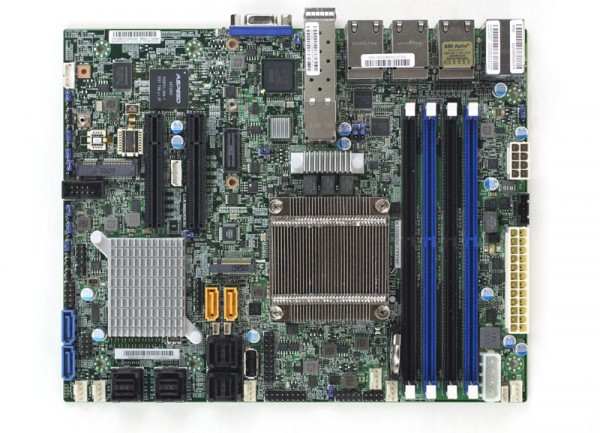
The Xeon D-1587 is a 65w TDP part, therefore Supermicro is using a taller, passive, 1U heatsink for this platform than we see on the 2 core to 8 core Xeon D platforms. Components including the CPU heatsink and the four DDR4 RDIMM slots (up to 128GB DDR4 RAM) are all oriented for standard server airflow. We even see the motherboard battery in a position to work with this ariflow.
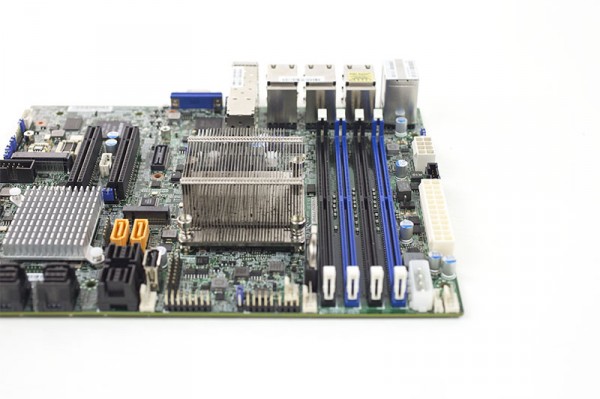
We do want to add here that this is still a 652 TDP SoC. As a result, chassis fan cooling is required. There are six 4-pin PWM fan headers onboard to ensure a chassis can get enough cooling over the SoC.
Moving to the PCIe expansion and slot storage, we see a number of slots with the X10SDV-7TP8F. There are two PCIe 3.0 x8 slots onboard for standard PCIe cards.

In addition to the standard PCIe slots, there is also a M.2 PCIe slot for storage. In this picture we have a Samsung SM951 512GB SSD installed in that slot. With M.2 SSDs being available for relatively low prices and with performance well above SATA SSDs, this is a welcome feature. We can also see the mPCIe slot (with mSATA support) on the motherboard. Here is what this looks like with a 64GB mSATA SSD meant for OS installations. Note that it is very low profile and one can use a 1U PCIe riser and still install components in this mPCIe slot.
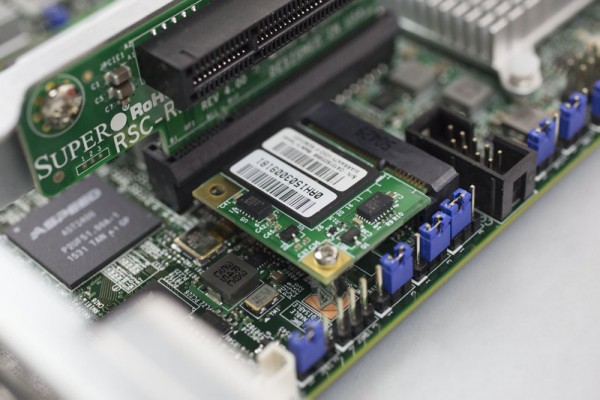
The bottom line is that in terms of expansion slots, the Supermicro X10SDV-7TP8F is a leap forward in being able to customize a Xeon D platform.
One of the high-end features of the X10SDV-7TP8F is the onboard LSI SAS 2116 SAS controller. You can also search under Avago SAS 2116 and now Broadcom 2116 for more information on this part. The SAS 2116 resides below the silver heatsink on the motherboard and provides 16x SAS 2/ SATA III 6.0gbps ports via four SFF-8643 connectors. This setup can handle a few SATA III SSDs or plenty of hard drives making it ideal for situations where one needs storage on the appliance.
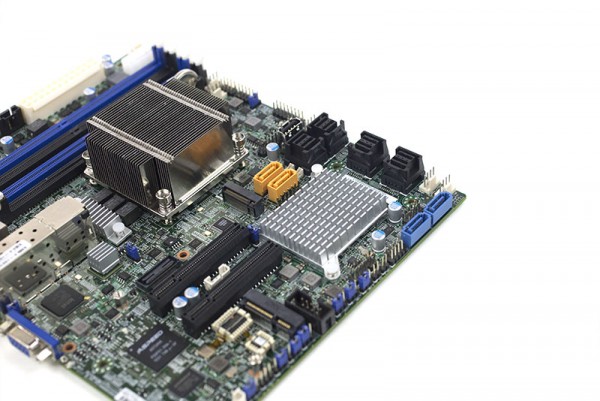
Beyond the 16x SAS 2 / SATA III ports there are also four SATA III ports, two of which (in orange) can support SATA DOMs. Finally, there is an internal USB Type-A header for a USB stick carrying either a USB license key FOB or for embedded installs for products like VMware ESXi. Summing up the storage capabilities in terms of what can be added without using an add-in card:
- 16x SAS 2 / SATA III 6.0gbps drives
- 4x SATA III 6.0gbps drives
- 1x m.2 PCIe/ NVMe SSD
- 1x mSATA SSD
- 1x USB thumb drive (internal)
If you were trying to consolidate an ESXi platform running network and storage applications there is a solid array of parts that can be used for everything from mass storage to caching drives.
On the rear I/O panel we can see two USB 3.0 ports and a VGA port which are used mostly for local KVMs. Above the two USB ports we can see an RJ-45 port that is meant for IPMI and out of band management. Perhaps one of the more unique features of this platform is that it is our first Supermicro Xeon D platform with dual SFP+ 10GbE networking. 10GbE using SFP+ is generally a lower power option and provides significant flexibility in terms of using either DACs or fiber SFP+ modules.
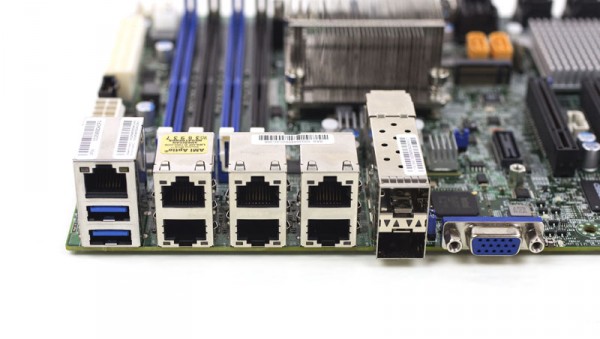
Between the USB 3.0 ports and the two SFP+ ports there is an array of 6x RJ-45 ports for 1Gb Ethernet. One can see the exposed Intel i350-am4 controller on the PCB as it is one of the largest ICs onboard. The i350-AM4 is a pricey network controller that is Intel’s current 1GbE flagship line.

One can see as we install Ubuntu 14.04.3 LTS that there are a total of six 1GbE network ports, the four Intel i350-AM2 and two Intel i210 ports. Both NICs are very well supported. The Intel X552/ X557 10GbE NIC integrated with the Xeon D SoC is supported in newer OS versions (e.g. Ubuntu 15.10) and we expect that we will see increased support in the near future. We are going to have a few guides in terms of what this platform can do and even have an installation script you can use to get the Intel Xeon D’s X552/ X557 drivers installed automatically using older Ubuntu/ Debian versions here.
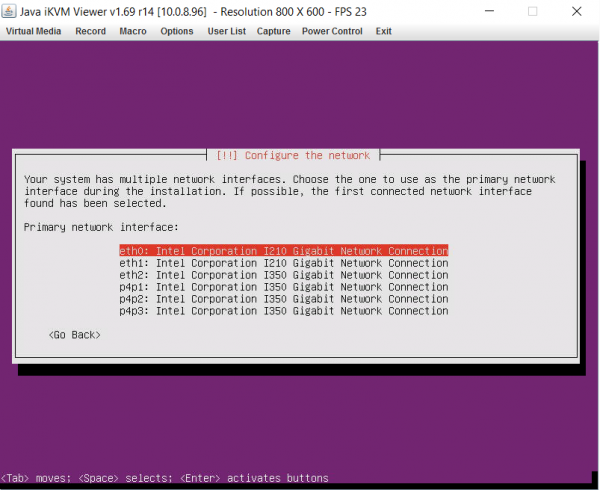
We do have this installed in our datacenter lab. As one can see, there are a total of 6x 1GbE, 2x 10Gb SFP+ and 1x out-of-band management port onboard the platform.

With a total of eight different network interfaces and the capability to support a plethora of storage options even before adding add-in cards, the platform is the most complete Intel Xeon D platform we have tested to date. With 16 cores and 32 threads onboard, this platform packs a multi-threaded workload performance profile more akin to two Intel Xeon E5-2670 V1s which each had TDPs higher than the entire server pictured above has (see our Intel Xeon D-1587 benchmarks.)
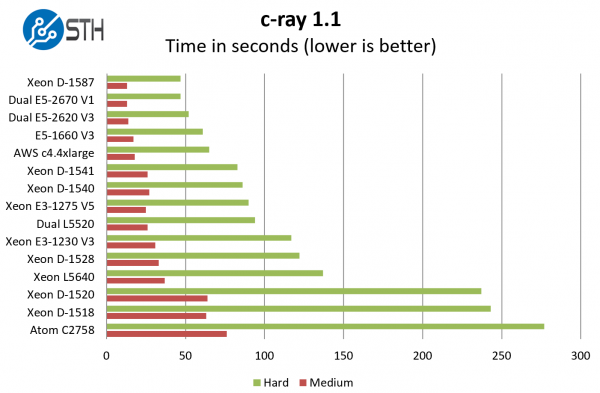
If you are looking for a hyper-converged appliance and need at most 128GB of RAM, the Supermicro X10SDV-7TP8F is awesome.
Supermicro X10SDV-7TP8F Thermal Imaging and Power Consumption
To capture these images we utilize our FLIR Ex series professional thermal imaging camera and turn on FLIR’s MSX enhancements so we can see components outlined clearly. We put the system under 100% CPU load for a period of 24 hours to let “heat soak” set in prior to taking the images. Here is a shot in our standard 22C to 60C range with the FLIR MSX overlay.
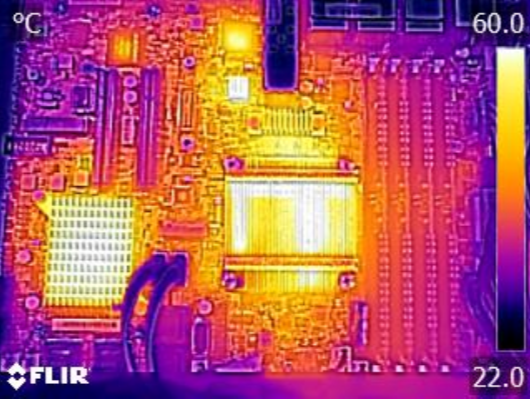
We can see the key hot spots being the SAS 2116 heasink, 10Gb PHY, Intel i350-am2 and the power delivery components to the Xeon D-1587 SoC. With all of the added components, this heat pattern looks much different than what we see at the lower end of the Intel Xeon D line.
We used our Extech TrueRMS Power Analyzer 380803 to take measurements at different points of the board’s use using 120V power.
- BMC only power off – 5.0w
- Ubuntu 14.04 LTS installation screen – 30.5w
- UnixBench 5.1.3 single thread max – 44.2w
- Multi threaded max observed – 91.8w
These results are excellent and our test configuration adding four Seagate Enterprise capacity 7200rpm drives, the SM951 M.2 SSD, the 64GB mSATA drive, redundant power and cooling all yields power consumption under 1A on 208V datacenter power which is very impressive.
Supermicro Management
Supermicro’s IPMI and KVM-over-IP as described a few times on this site, allows for a lot of deployment flexibility. Things such as fan speeds, chassis intrusion sensors, thermal sensors, and etc. can be monitored remotely. Alerts can be setup to notify the admins of issues. Beyond this, the functionality also allows for remote power control. One can do remote power up, power down, and reset of the server in the event that it becomes unresponsive.
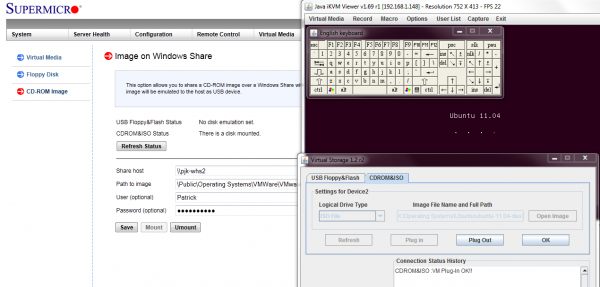
Another important feature is the ability to remotely mount CD images and floppy images to the machine over the dedicated management Ethernet controller. This keeps maintenance traffic off of the primary Intel NICs. At the same time it removes the need for an optical disk to be connected to the Supermicro motherboard.
The latest revision of Supermicro’s BIOS has a great feature: the BMC IP address shows up on the post screen! This is a super feature because if one has a KVM cart hooked up to the system, it gives an indicator of which machine one is connected to during post.

Supermicro does include KVM-over-IP functionality with the motherboard. We have been testing servers from HP, Dell, Lenovo and Intel that all required an additional add-in key to get this functionality. It is an absolute time and money saver in the datacenter and other vendors should follow Supermicro’s lead in this space.
Conclusion
We still do not have estimated street pricing but there are vendors (with no stock) listing this motherboard in the $2200 range. While this may seem steep there are a few considerations which need to be taken into account. First, Intel has not released the official Intel Xeon D-1587 pricing from what we have seen at the time of this writing, but we expect it to be in excess of the D-1571 which sells for around $1220 USD. Intel is trying to protect the low end of the Xeon E5 line by keeping the selling prices of the 12 and 16 core Xeon D chips high. Second, this platform has the equivalent of a $400+ LSI SAS 9201-16i onboard (using newer SFF-8643 connectors) and 6x 1GbE NICs added. If you can use the onboard networking and storage, then there is a lot of value in the integrated platform. Finally, there are many Intel Xeon E5 systems from the V1 through V3 generations running 128GB or less of RAM that could see power consumption slashed by 1/3 or more by this platform. The operational costs alone could save hundreds or more each year using a platform such as this. The Intel Xeon D lineup will continue to mature as Intel releases new chips. As of now, the Supermicro X10SDV-7TP8F is the ultimate Xeon D platform for hyper-converged, storage and networking solutions.

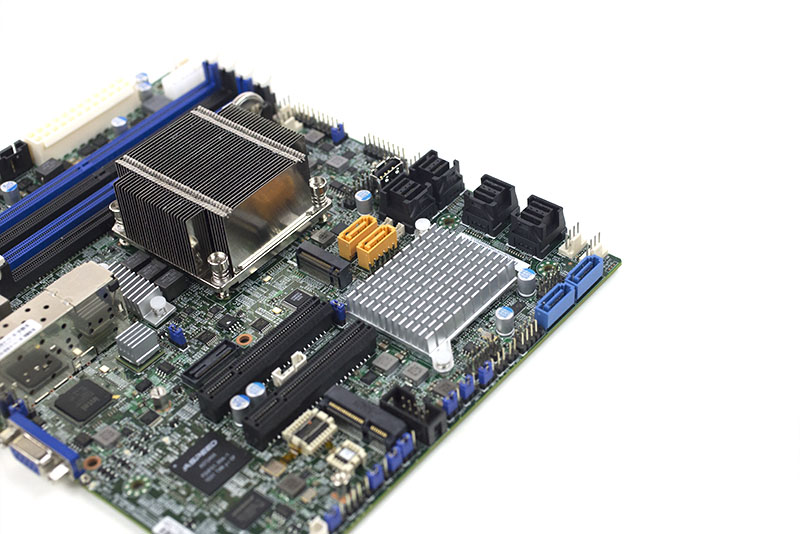



Would it be possible to do some video encoding benchmarks to see how it fares against higher clocked CPUs? I feel that this platform would be immensely powerful for x264 encoding for the power consumption.
One thing that annoys me about most, if not all BMC KVM over IP solutions but especially the one employed by Supermicro is that it is so poorly built that it is almost useless. Using a Java Applet / Webstart thing to connect to a server is such a poor way to do it and is so fraught with incompatibilities that it’s often more than a pain in the ass than connect directly to the server, especially when not using Windows with some specific / outdated Java version which is usually a huge security hole in itself. There is no support for protocols like VNC, SPICE or RDP.
Is the processor soldered to the motherboard?
Yes